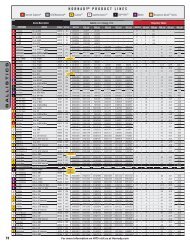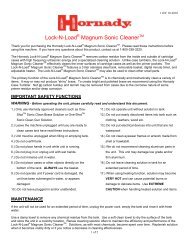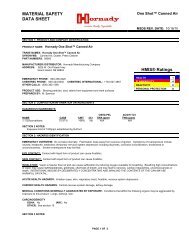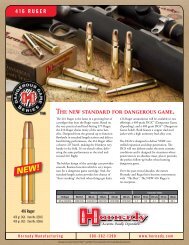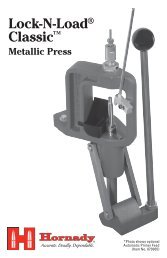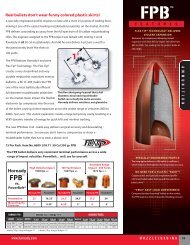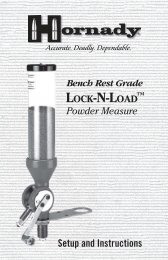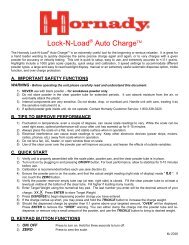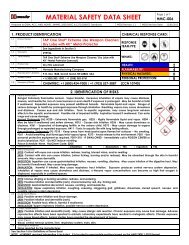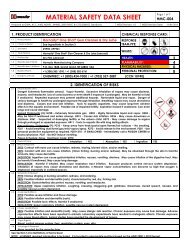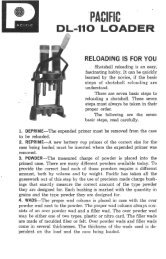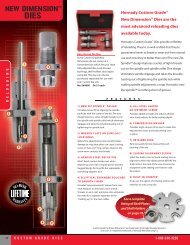You also want an ePaper? Increase the reach of your titles
YUMPU automatically turns print PDFs into web optimized ePapers that Google loves.
<strong>Hornady</strong>’s CriticalDefense is the firstand only handgunammunition linedesigned andengineered at alllevels specificallyfor the needsand situation ofthe modernarmed citizen.By Dick Metcalf, Executive Technical EditorThis 185-grain .45 ACP Critical Defense bullet from a 3-inchModel 1911 penetrated 11 inches of ballistic gelatin after passingthrough a heavy clothing barrier. Note fabric and downmaterial pasted to nose of polymer insert, which could haveplugged the nose cavity of a conventional hollowpoint bullet.For personal-defense or homedefensehandguns, particularlyfor the ever-growing numbersof compact and short-barreledpistols and revolvers on the market,proper ammunition choice can literallybe a life-or-death decision. Thischoice is neither simple nor easy,and there are many considerationsto be weighed. <strong>Hornady</strong>’s CriticalDefense ammunition line offers aremarkable new alternative for themillions of Americans who are takingadvantage of their legal rightto carry firearms concealed on theirpersons for protection.The fundamental purpose of apersonal-defense handgun cartridgeis to incapacitate a violent attackeras quickly as possible—to make himstop his assault before he can dealinjury or death to you or your lovedones. Put bluntly, the bullet from apersonal-defense handgun load mustbe able to penetrate deeply whileopening as large a wound channelas possible, disrupting critical organfunction and causing immediate,massive loss of blood pressure andattendant neural/motor function.Not “knock-down” power (there’s nosuch thing), but disruptive power.For this reason, expanding hollowpointbullet designs have alwaysbeen preferred for personal defenseas opposed to solid nonexpandingbullets, which can penetrate deeplybut do not typically cause immediatelydestructive organ damage evenwhen passing through vital areas.Unfortunately, there has been afundamental drawback to expandinghollowpoint bullet design ever sincethe very first popular high-performanceJHP handgun ammunitionline, SuperVel, appeared on the marketin the late 1960s. Hollowpointsare by definition more fragile thansolid-design bullets. They have to bein order to upset. But this verycharacteristic also makes themsubject to interference or damagefrom impact with external and internalmaterials such as clothing orbone, which can prevent them fromexpanding as designed (or causethem to expand prematurely andprevent sufficient penetration).All the many hollowpoint bulletdesigns currently on the market(and there are many good ones)operate by the same basic principle.When a hollowpoint strikes tissue,pressure-liquefied protoplasm(which is 90 percent water to beginwith) at the point of impact is forcedinto the hollow nose cavity, generatinghydraulic pressure that forcesthe cavity open, peeling back thejacket material and “mushrooming”the internal core material. That’sif everything goes right. But if thenose cavity is blocked, either bybeing plugged (the “cookie-cutter”effect) or collapsed by barrier52 SHOOTING TIMES/DECEMBER2010/JANUARY2011 shootingtimes.com
material or bone prior to deep-organimpact, hydraulic force is preventedfrom entering the cavity and thebullet essentially becomes a solid,failing to expand.For many years, hollowpointbullet performance was judged andcompared by being fired into blocksof bare ballistic gelatin without any“barrier material” interposed priorto impact. (I have never forgottenthe comment of a veteran major-citystreet cop from those days, who,after reading a gel-block performancereport on one ammo maker’snew load, remarked, “That’s all verywell and good, but we’re not oftenrequired to shoot at naked people.”)Then, following a widely publicized1986 shootout in Miami wheretwo FBI officers were killed whileattempting to apprehend two criminalsinside a vehicle, a new performancestandard and test protocolfor judging law enforcement handgunammunition was developed. Itrequired minimum bullet penetrationand wound cavity standards inballistic gelatin after penetrating avariety of barrier materials, includingdifferent thicknesses of clothing,wallboard, sheet metal, and automobileglass. This new FBI Standardrevolutionized ammunition developmentand led directly to today’s widerange of high-performance hollowpointhandgun bullets.However, even the best of today’shollowpoint designs are stillsubject to cavity plugging fromfabrics under certain conditionsand to nose collapse fromoblique impact with boneand other barrier material.Also, it is criticallyimportant for an armedcitizen to understand thatpersonal-defense ammunitionstandards and lawenforcement ammunitionstandards are not thesame—and should notbe. Police officers maybe called upon by theirduty to exchange firewith criminals concealedbehind walls or inside a vehicle. Foran armed citizen, legally justifiable“personal defense” is just what theterm implies: personal. Up close,exposed, face-to-face. Even in themost armed-citizen-friendly states,a civilian who shoots at a criminalblocked behind a wall or inside avehicle will likely be considered bylaw to be engaged in a gunfight, notin self-defense. We can all imaginecircumstances (think drive-byshooting) where returning fire at anobscured target might be our devoutwish, but shooting at a vehicle thatmight also contain non-combatantson a public street is still a universallegal no-no.The Critical BreakthroughWith all these considerationsin mind, a few years ago <strong>Hornady</strong>embarked on a program to developa line of ammunition specifically forcitizens who carry or use compactconcealable handguns for personaland in-home defense: a productline that would not be designed tomeet law enforcement standards forwallboard, sheet metal, or auto glassbarriers but would totally resolvethe age-old problem of hollowpointcavity plugging when penetratingan attacker’s clothing. Not just someof the time, not just most of thetime, not just nearly all of the time,but each and every time. The result,after extensive experimentation andtesting, is Critical Defense.The key to the Critical Defenseperformance breakthrough is theFlat-tipped Critical Defense FTX bullets employ a softer, more malleablepolymer nose insert than is used in pointed LEVERevolution FTX bullets.application of a variant of <strong>Hornady</strong>’ssoft polymer-nose Flex Tip (FTX)bullet design, which was originallydeveloped for the company’sLEVERevolution line of lever-actionrifle ammunition to allow loadingof ballistically efficient pointed bulletsin a tubular magazine withoutdanger of primers being ignitedunder recoil. At a glance, a CriticalDefense bullet looks like a Flex Tipbullet with the tip of the polymercavity insert cut off at the front ofthe jacket. That’s almost right, butnot exactly.The polymer used in pointedFlex Tip bullets is pliable butnot squishy. The Critical Defensepolymer is much more compressibleby comparison, and a piece of theinsert material is easily malleable ifsqueezed between finger and thumb.The cavity itself is wide, deep, andstraight-wall cylindrical with a flat90-degree-edged bottom.The best way to understand thefunction of the design is to thinkthat what <strong>Hornady</strong> has done is usea hydraulically active medium toessentially “pre-fill” a very large hollowpointnose cavity, thus eliminatingthe hole that might be pluggedby an attacker’s clothing or othermaterial while providing a jumpstartto the expansion process. Uponimpact, the soft insert polymer iscompressed by the resistance of thetarget tissue and swells to impartequalized outward pressure aroundthe entire circumference of the bulletcavity, causing the same uniformupset and expansionas if an open hollowpointwere fired intoa “naked” unclothedmedium. It worksunfailingly whetherfired through lightsummer clothing,heavy layered winterclothing, or evenleather. The presenceof the insert materialalso resists nose collapseshould the bulletglance against boneshootingtimes.comSHOOTING TIMES/DECEMBER2010/JANUARY201153
<strong>Hornady</strong>’s Critical Defense ammunitionline is currently offered in these sevenloads, and more are on the way.just under the target’s skin (think, arib), allowing the hydraulic expansionmechanism to keep operating.Incidentally, the leather thingreally impresses me. A few yearsback I shot a 150-pound whitetailfacing directly chest-on at about 20yards with one of the best performing.41 Magnum modern hollowpointloads on the market. It wheeled andstreaked away. After tracking theanimal (essentially no blood trail)for nearly a mile, I found it dead. Irecovered the bullet from the rearthigh, nearly 3 feet of full-lengthpenetration through lungs, liver, andviscera. It was essentially reloadable—zeroupset. The hollow cavitywas plugged full with a perfectlycircular wafer of cut-out deer hide,hair still attached. The hollowpointhad become a solid on impact. If ithad not plugged, and had expandedas designed, the deer would havemerely stumbled a few steps andcollapsed.So I ask myself: Which resultwould I prefer if facing an attacker?One that falls down right there orone that can still run a mile?<strong>Hornady</strong> initially introducedCritical Defense ammunition inearly 2009 with 90-grain .380Auto, 115-grain 9mm, standardpressure110-grain .38 Special, and110-grain .38 Special +P loads. Newfor 2010 are 165-grain .40 S&W,185-grain .45 ACP, and 125-grain.357 Magnum loads. More will becoming.The bullets for each caliber/loadare designed so that the compressibilityof the polymer insert material,the thickness and taper of theexternal jacket, and the skivinggrooves in the jacket’s ogive areindividually tailored for specificbullet velocity and weight. Plus, allloads are optimized for performancewith velocities from short-barreledcompact-concealment pistols andrevolvers, while also maintainingperformance in full-size guns of thesame calibers.Their performance is impressive.54 SHOOTING TIMES/DECEMBER2010/JANUARY2011 shootingtimes.com
Hands-On Test ResultsMy first experience with <strong>Hornady</strong>’sCritical Defense ammo waswith the 90-grain .380 Auto load. Ifired it at a distance of about 15 feetfrom a palm-sized 2.75-inch RugerLCP into a block of ballistic gelatin,fronted by an FBI-standard “heavywinter clothing” barrier consisting oflayered cotton T-shirt material, lineddenim jacket material, and a downfilledparka. The bullet expandedAll Critical Defense loads are optimized foreffective performance in compact carryconcealedhandguns.These fully upset .45ACP and .40 S&WCritical Defense bulletsfrom standardsizepistols wererecovered fromballistic gelatin afterpassing throughstandard FBI-protocolfour-layer “heavywinter clothing” barrier.Penetration was12+ inches for all.instantly and fully, and it penetratedstraight-line to a depth just over10 inches. That’s deep enough topenetrate and disrupt any attacker’svital engine and equal to what Iwould normally expect from a conventional9mm JHP load from thesame barrel length. Repeated firingsduplicated the result. My attitudeabout the potential of the “marginal”.380 Auto for effective personaldefense was instantly changed. (Youmay have watched me doing that, inreal time, on Guns & Ammo Television,and the video is also availablefor view on the <strong>Hornady</strong> website:www.hornady.com.)More recently, I repeated the sameheavy clothing scenario with thenew Critical Defense 185-grain .45ACP load, this time from a SpringfieldMicro Compact 3-inch Model1911. Penetration this time was 11inches, with picture-perfect expansionso perfectly symmetrical thatthe bullet ended up exactly front-on,with no yaw or tumble, and the redpolymer Flex Tip plug coming to restabout a half-inch directly in frontof the bullet. That only happensshootingtimes.comSHOOTING TIMES/DECEMBER2010/JANUARY201155
CRITICAL DEFENSE RANGE RESULTSwhen a bullet’s upset isperfectly concentric, andMore Than The BulletStandardit’s extremely unusualVelocity Deviation Accuracy There is more towith conventional hollowpointAmmunition (fps) (fps) (Inches) Critical Defensedesigns even in.380 Auto Taurus TCP, 2.84-Inch Barrel, 21 Feetammunition thanbare gelatin much lessjust the bullet, and<strong>Hornady</strong> 90-gr. FTX 933 19 2.75after plowing throughit is in fact one ofa down parka. Interestingly,9mm Luger Glock 19, 4-Inch Barrel, 50 Feetthe most thoroughlythe flat nose of <strong>Hornady</strong> 115-gr. FTX 1135 16 3.88 thought-out prod-the polymer insert was.38 Special S&W Model 360 PD, 2-Inch Barrel, 21 Feet ucts of its type everpasted with a circle of <strong>Hornady</strong> 110-gr. FTX 993 20 2.90 developed. <strong>Hornady</strong>mixed fabric, which tellshas also taken full.38 Special +P S&W Model 360 PD, 2-Inch Barrel, 21 Feetyou what would haveadvantage of the same<strong>Hornady</strong> 110-gr. FTX 1087 23 2.25happened to that bulletrecent advances inif its hollow cavity had.357 Magnum S&W Model 386 AirLite, 3.13-Inch Barrel, 50 Feetpropellant technologyactually been hollow. <strong>Hornady</strong> 125-gr. FTX 1388 25 3.00 it uses in its highperformanceFrom a full-size 5-inch.40 S&W Springfield XD, 4-Inch Barrel, 50 FeetrifleSpringfield TRP 1911, <strong>Hornady</strong> 165-gr. FTX 1153 21 3.75 innovations, such asincidentally, full-upsetthe Compact Magnumrifle cartridges,.45 ACP Colt Commander, 4.25-Inch Barrel, 50 Feetpenetration of the<strong>Hornady</strong> 185-gr. FTX 975 17 3.50.45 ACP load reachedto power its CriticalNOTES: Accuracy is the average of three, five-shot groups fired from a12.5 inches, and theDefense loads with asandbag benchrest. Velocity is the average of five rounds165-grain .40 S&Wmeasured 10 feet from the guns’ muzzles.low-signature muzzleCritical Defense loadaveraged 13 inches from a 4-inchSpringfield XD. Accuracy of allCritical Defense loads is the same asyou’d expect from any of <strong>Hornady</strong>’spremium-grade handgun ammo, asrevealed in the chart.flash, lower-thanstandardrecoil compared to samebullet-weight/same velocity loadswith conventional propellants, and56 SHOOTING TIMES/DECEMBER2010/JANUARY2011 shootingtimes.com



